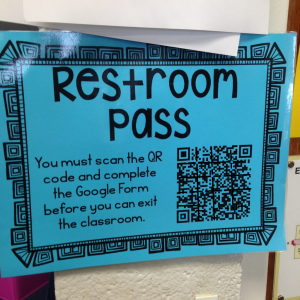(QR code has been altered somewhat for privacy purposes. Note that the pass was for kids in mid-elementary school. We are talking possible third-graders here.)
Posted by the door, this pass makes restrooms visits so easy. You scan the code, complete the form and then you are allowed to go to the bathroom. I expect the pass with its QR code is tracking both when and how often students go to the bathroom. In middle or high school, the QR/Google bathroom pass could quickly reveal those students who exit class for five to ten minutes every hour on the hour. I love this pass.
I’d like to relate back to my last post, though. What do we know about the kids using this pass? These students happen to be among the highest-scoring PARCC students in the state of Illinois. They remain attached to their IPads throughout the day. Because I helped load software onto those IPads, I know these children have oodles and oodles of apps to use throughout the day, and IPads that can go home at night.
Many students in other districts are less fortunate. Classes may even share carts of IPads. Those IPads stay at school at the end of the day, rather than being checked out to students. Homework takes place on paper rather than GoogleDocs. That homework must be placed in a box, rather than sent electronically to the teacher.
I’ll be the first to argue that students do not require technology to learn. The famous mathematicians of the past never played Math BlasterTM. Edward Gibbon wrote The Decline and Fall of the Roman Empire entirely by hand. America’s forefathers are known by their signatures, not their coding skills.
But now that we are giving our annual state tests on computers, familiarity with computer technology and touchscreen features adds speed and comfort during the testing process. Students who use the above bathroom pass daily and take their IPads home enter the state testing process with a marked advantage over students who only sometimes pull IPads out of carts and who must rely on home technology after the end of the school day. In many impoverished households, the only available home technology will be mom or dad’s smart phone — when that phone can be made available. Those phones often accompany mom or dad to work in the evening.
Eduhonesty: As we play technological catch-up, this aspect of teaching and testing needs to be out front, not on the backburner. How many points were lost on the last few PARCC tests by students who understood the math, but were regularly slowed down by unfamiliar technology. Nobody knows.
Until access to our technological platforms equalizes between zip codes, I am calling for a return to pencil and paper testing. I have watched students in our poorest districts taking computerized tests in slow, poking, keyboard motions, highlighting nothing or everything, and ignoring useful tabs, some even struggling to drag and drop items across the screen. America should bring back pencils and bubble sheets for the annual state test. As I sub in various districts, I simply see too much variation in technological exposure to believe that fully-computerized testing can be fairly administered.
P.S. This post applies to PARCCTM testing and other computerized tests that provide the same content to all. Because of the adaptive character of Smarter BalancedTM testing, I might not feel the same about Smarter BalancedTM or MAPTM testing. The benefits from adapting a test based on student responses may justify using these tests, despite the unfortunate differences in technological practice and comfort between students.

